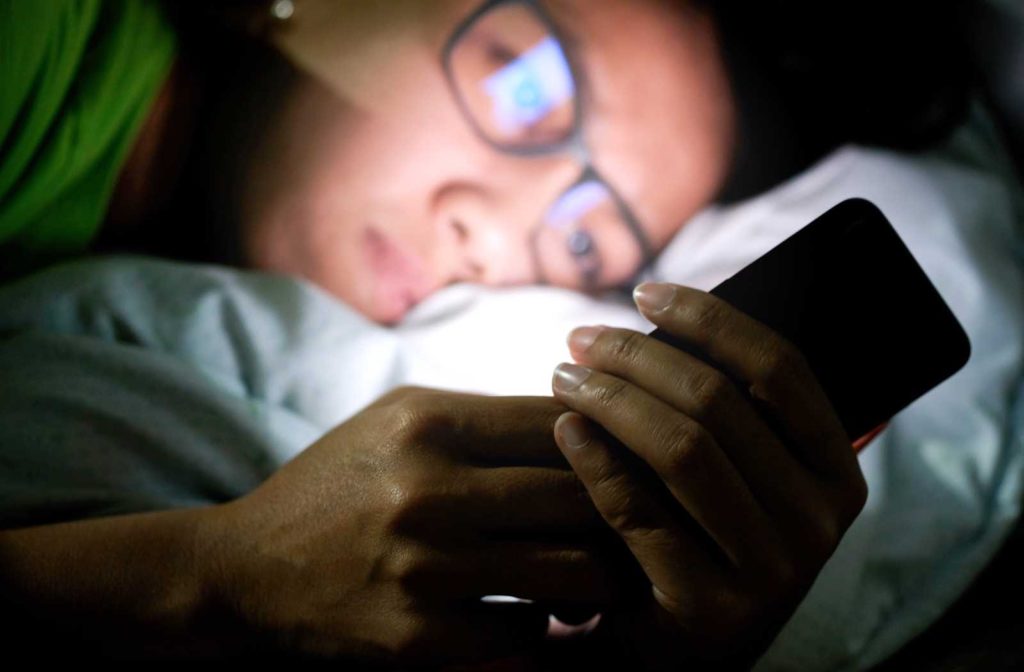Blue light has gained some attention lately, as more and more people talk about what harm it might induce in your eyes over time. Screentime with smartphones is becoming more and more common for our patients, and some show signs of fatigue at scheduled eye exams.
Digital devices put out white light, so you can interact with your favourite apps and all sorts of media. But that light breaks down into the visible spectrum, and it can include significant levels of blue light. Patients and eye doctors alike are interested in the link between blue light and digital eye strain.
Eyestrain Vs Digital Eye Strain
One thing that gets lost in translation when people talk about digital eye strain and eye strain is that they’re not exactly the same thing. You can have eye strain without digital sources. Digital eye strain is eye strain specific to use of digital devices.
What Makes Digital Eye Strain Unique?
One study done by the University of Iowa found that a random sample of people blinked 66% less when using a digital screen than without. That’s part of it.
Brightness is another factor. It’s easy to set an excessive brightness level at high noon, and forget to turn it down—when you’re winding down in the evening with the same device.
And a notable part of digital eye strain that makes it unique is the potential for high concentrations of blue light. Blue light comes from several sources, but many eye doctors note the rise in artificial sources of blue light for their patients.
Blue Light & HEV Light
Blue light also goes by the name high energy visible (HEV) light, because light carries energy proportionate with its wavelength! Shorter wavelengths mean more energy, and HEV carry a bit more, falling within a range of about 500nm to 380nm in wavelength.
It’s not as high energy as ultraviolet (UV), but it’s up there! In fact, blue light can reach your retina, where it can interact with your biology, even beyond your eye. UV light, carrying excess energy, more often interacts with parts of your eye not quite as deep, like your eyelids, cornea, and ocular lenses. Still, UV can be linked to age-related macular degeneration at the retina.
Does Blue Light Cause Digital Eye Strain?
Blue light hasn’t been directly linked as a firm cause of either age-related macular degeneration, or digital eye strain. But some studies have shown that excessive bombardment of retinal cells from blue light can be damaging. The problem is, those studies weren’t conducted on living patients outside of a lab, so it might not be so simple.
On the other hand, researchers simply don’t know the long-term effects of entire generations of people absorbing blue light at all hours of the day. The data isn’t there yet; time will tell.
How Blue Light and Eye Strain Are Linked
The other thing is, blue light scatters. This scattering effect can create “visual white noise,” meaning your eyes might strain trying to render images rich in blue light.
Ultimately, blue light doesn’t cause digital eye strain, but it really doesn’t help with eye strain either. Screened devices seem to have effects on our brains and minds a bit more than our eyes.
Blinking Less
According to the University of Iowa, a random sample of people blinked 66% less when using a digital display than without. Insufficient blinking habits can lead to dry eye disease, which manifests as red coloration, irritation, and more. Digital eye strain can magnify the effects of dry eye as well.
Sleeping Around Blue Light
Aside from digital eye strain, blue light’s most observable effect has to do with brain chemistry. Your brain releases a sleeping chemical called melatonin, which tells your body it’s time to sleep. When your retina picks up blue light, your brain should get a signal to suppress melatonin, meaning your sleep can get disrupted, even at night. Sleep disruption can lead to more kinds of fatigue than just eye strain.
Blue Light Filtration
At this point you might be wondering how you can curb blue light in your life, and that’s understandable. Better to err on the safe side, as always. Fortunately, a few easy, low-impact implementations stand out if you’d like to limit your exposure:
- Blue light filtration lens coatings available for prescription eyeglasses
- Blue light screen covers for your devices
- Device settings allowing for dark or night modes with warmer colours
Blue Light Sources
The sun is hands down your biggest source of blue light, as a part of the intense white light it emits. Sunlight makes up 55% of your eye’s average blue light exposure. If you can reduce sunlight with sunglasses during the day, you can hedge your bets against possible dangers from blue light decades from now. High-quality sunglasses are your best bet.
Blue light can be effectively filtered by quality sunglasses by about 60-92%. Then at night, you can wear eyeglasses with blue light filtration if you want to go even further.
Blue Light Filtering Multifocals for Presbyopia
Presbyopia is a natural part of ageing. Your cornea—mostly responsible for bending images composed of light and shadow into the back of your eye—thins over time. That makes the process of correcting them a simple matter of wearing the right prescription.
If your vision was 20/20 before you started to notice the effects, then that prescription would start to show a positive number, and in that case you could probably settle for some part-time reading glasses.
Reading glasses are a popular solution to low-level far-sighted refractive error experienced by those with presbyopia. For looking into the distance, patients with mild cases of presbyopia just need help with up close work on a computer or with books.
Reading Zone Placement for Combatting Eye Strain & Digital Eye Strain
Of course, reading glasses for computer work brings in the opportunity to filter against blue light, just to be safe. Multifocal glasses (or bifocals for that matter), have a “reading zone” ergonomically placeable at the bottom half of the lenses.
Then, you can have a blue light filtering lens coating applied, so your close up computer work is doubly protected from eye strain and digital eye strain stemming from blue light.
Curbing Digital Eye Strain
Blue light filtration can help. But ergonomics and screen-time breaks greatly reduce digital eye strain. Ideal viewing distance and posture, as well as time away from the screen can also help with the remote possibility of blue light dangers. If you need your devices at all hours of the day, there’s no need to worry. The following can provide relief from accumulating digital eye strain.
20/20/20 Rule
If you need a lot of screen time for work, the 20/20/20 rule is a must. After every 20 minutes of screen time, relax and shift your gaze to something 20 feet away, and count out 20 seconds. That way, your eyes can get a bit of much needed rest.
Ergonomic Posture
The magic number for how to hold your device is 45! You should always be looking down at your screen if it’s going to be long periods, with your head level, and your gaze at a 45-degree, downward angle. If you can minimize glare in your sitting position that will also help with eye strain.
Take Control of Blue Light & Eye Health
From sunglasses, to device display settings, to blue light filtration eyeglasses and readers, your options for managing blue light exposure certainly aren’t limited. But you should focus on the actual threat of eye strain rather than the possible cause, artificial blue light.
If you need advice, or you’re seeking help with either blue-light filtration or relief from digital eye strain, the best step you can take lies in getting your eye exam and talking to your eye doctor. We’re here to help, so please book an appointment.




